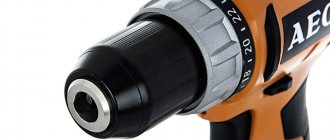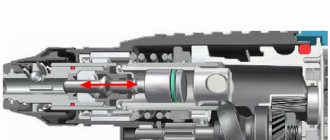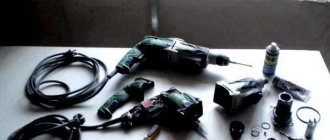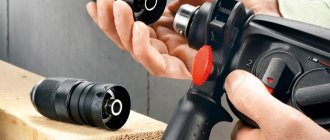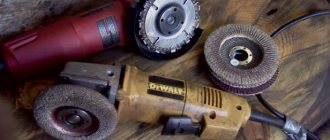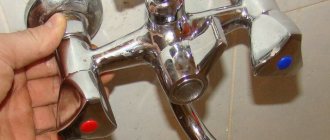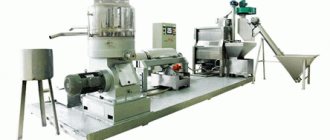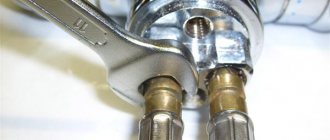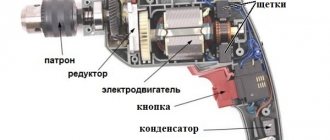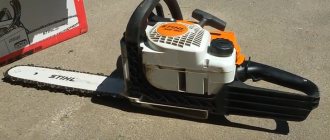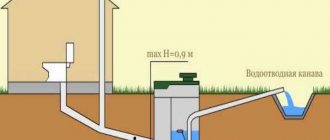No hammer blow. What to do in such cases?
When drilling holes with a hammer drill, the main factor is not the rotation of the drill, but the impact. Its strength determines both the drilling speed and the ability of the tool to handle particularly tough materials (concrete, granite, etc.).
Dust and constant stress on the tool have a negative impact on its effectiveness. During operation, the impact force may noticeably decrease or completely disappear.
How does an impact drill work and why does it refuse to hammer?
Reverse doesn't work
Reason . The mode switch button is broken. Disassemble the back panel and, if necessary, change the contacts.
Repairing a rotary hammer
If the shock does not engage, you can start the test with the start button. First, turn off the hammer drill. We remove the protective casing to get to the switch contacts and make calls throughout the circuit. On the way, we check the wires for breaks (in most cases at the plug and specifically at the junction with the equipment). If the button contacts are fine, the problem is most likely in the engine.
If there is no burning smell, the windings are not affected, and the rotor rotates freely, then the brushes will wear out. There are always two brushes, they are made of metalgraphite. They are pressed against the collector by springs, and during operation they wear out and become shorter. Their pressure on the manifold is reduced, the contact worsens and the engine stops working normally.
Take out the brushes and inspect them. Check how they fit in the holder; if they are very skewed, they are worn out. From time to time, special paint is applied to them to make it clear that it is time to change the brush. Purchase the latest brush that is suitable only for this model of electric motor.
If the brushes are fine, things are bad. The stator or armature is damaged. Their winding can be destroyed in the following way: breakdown, breakdown of electronic failure, breakdown “to the point”. At this step, it is better to entrust the repair to specialists. A drop in power is usually also associated first with wear of the brushes. If they're ok. The anchor is out of order. If the drill-hammer began to vibrate very much, being removed from the hands or making a louder noise than it would normally be in the box. Perhaps the bearings are worn out, the balance of the parts is imbalanced, the gears are skewed, or free play appears. You will need to independently change the bearings or balance or change the gears.
A strong sparking and burning smell indicates a broken fitting, which will lead to costly repairs.
READ Impact and non-impact drill screwdriver differences
The attacker pushes the drill, rotating between the piston and shank. The more you press the hammer into the wall, the more often the impact occurs. Due to the decrease in stroke, the impact force becomes less. This disables the attacker. It can be replaced with a new one.
The hammer drill does not rotate under load
Most likely, the load does not correspond to the permissible norm, as a result of which this deficiency appears.
Rotary hammer design, assembly diagram and spare parts list
The tool consists of a single-phase motor and rotor. The gear located on the valve shaft is responsible for rotational movements. Between them there are bearings, one of which is “drunk”; it transmits movement to the working parts.
Barrel hammer drill repair
This procedure is no different from repairing an ordinary drilling rig. It must be emphasized that the motor and shaft are placed vertically.
The hammer drill does not work - How to repair the hammer drill if it stops working. We find out the causes of tool failures
- Main
- Questions and answers
- The punch doesn't work. How to repair a shock if it stops working. Determining the circumstances of tool failure
The main causes of hammer drill breakdowns
The main difference between a rotating hammer and many other power tools. This is working in a very dusty environment. Its engine is cooled by a fan. The cooling air contains a lot of dust particles, which, penetrating into the tool, are rubbed against the fittings and stator, which leads to their rapid wear. To extend the life of these parts, you need to clean them from dust from time to time.
Sketch 3. Stator diagram.
Another frequent breakdown of the tool is associated with the mechanism for switching operating modes (rotation, combat, collision rotation). Therefore, if your blow does not engage, for example, in rotation mode, then you should disassemble the tool and visually check the switching mechanism.
Quite often, hammer drill breakdowns are associated with the chuck, since it is subjected to enormous loads during operation. You can protect your equipment from such harm by occasionally cleaning the cartridge from dust and dirt with a rag soaked in gasoline.
Rotary hammer repair: advice from professionals on disassembling household and professional devices
A hammer drill is an indispensable tool for drilling holes in concrete walls and many other similar works. Sometimes this device may break down. This article describes the device and principle of operation, diagnosis of the most common faults and how to repair a rotary hammer with your own hands.
Device design
The hammer drill has a strong impact function that a conventional drill does not have. This is achieved by the presence of special design elements that create a pneumatic push of the working tool with high kinetic energy.
The rotating motion of an electric motor is converted into oscillatory motion by compressing air between two pistons. Compression is created by vibration of the piston, which is transmitted to it from the electric motor using a special gearbox.
Despite the complexity of the design, most breakdowns are easily diagnosed and fixed; in difficult cases, to repair rotary hammers, you should first refer to the detailed instructions.
Basic faults
There are more than a dozen of the most common causes of rotary hammer malfunctions. Breakdowns can be caused by mechanical or electrical problems.
When the motor is running, the following mechanical breakdowns may occur: the drill does not rotate, it does not make impact movements, the drill is not fixed in the chuck or is stuck in it, there are extraneous noises when the equipment is operating.
The following characteristic signs indicate an electrical malfunction: there is no attempt to rotate the electric motor, strong sparks are generated on the electric brushes of the commutator during operation, acrid smoke is emanating from the device or there is a corresponding unpleasant odor.
Repair procedure
In order to repair the equipment, it must be disassembled. To do this, you need the following equipment: wrenches, screwdrivers, vices and bearing pullers. When lubricating mechanical parts, you will need a rag and solvent.
To repair the electrical part of the hammer drill, you may need winding diagrams and wires.
To disassemble the device, you must first remove the cartridge. After this, the body opens. If necessary, you can open only the part with the engine or the compartment with the gearbox. To repair faulty parts of a rotary hammer, you should first study photographs of such work.
Let's look at the most common equipment malfunctions, the procedure for inspecting and repairing rotary hammer problems.
The hammer drill does not hit
The device turns on, you can use it to drill holes like an ordinary drill, but the impact mechanism does not work. This malfunction may be caused by a failure of the floating bearing or destruction of the striking mechanism. In this case, the failed parts must be replaced.
No rotation
When the device is turned on, lack of rotation may be caused by electrical or mechanical faults. If the device does not react at all when turned on, then the problem is electrical. A wire could break, a switch might break, or the motor coils might short out.
If instead of working there is a hum, but there is no rotation, then the problem is mechanical: the rotor of the electric motor cannot perform rotational movements.
Sparking brushes
The most common cause of sparking is reduced brush thickness. As they decrease, the pressure of the pressing springs weakens, and an additional gap appears through which large sparks jump.
If replacing the graphite brushes does not help eliminate sparking, then the reason lies in a short circuit in the stator or rotor windings and they need to be rewinded. A tester is used to find a short circuit.
In order to reduce the likelihood of motor failure, it is necessary to monitor the condition of its brushes and bearings. The windings should be coated with an additional layer of dielectric varnish. Keep engine parts clean. Dust easily settles on a surface coated with lubricant.
High heat
Excessive temperature rise during operation may be caused by a motor malfunction. In this case, immediate repair is required.
Replacement of main parts
When using the device, you must ensure that it is in good working order. When the first signs of a malfunction appear, urgent repairs are necessary. In order to avoid serious repairs, you need to monitor the condition and, if necessary, change the following elements: bearings, power button, graphite brushes and cartridge.
The bearing is replaced if lubricant has leaked from it, it turns hard or creaks. To perform this operation you will need a puller and a wooden hammer.
The power button is very easy to change. This requires disassembling the case. In this case, it is necessary to ensure that the device is disconnected from the network.
The brushes are also very easy to change. Professional equipment does not require disassembling the housing. The hammer drill chuck can be replaced entirely or failed elements can be replaced.
In order for the equipment to serve for many years, it is necessary to perform maintenance, keep it clean, regularly clean and lubricate moving parts and replace brushes and bearings. In this case, repairs may not be necessary at all; the equipment will serve properly for many years.
Photo of the hammer drill repair process
Troubleshooting a rotary hammer with your own hands
Drill for mountain. This is a complex device consisting of electronic and mechanical components. Continuous operation of this device can lead to various breakdowns and defects, especially if preventive maintenance is not carried out. To extend the service life of the tool, and also to prevent sudden breakdowns, you should disassemble the hammer drill
and carry out diagnostics.
If it happens that the hammer drill refuses to work, then you should not rush to buy a new unit, even if your tool is already 10 years old. It can be taken to a repair shop, but the price of the services will be quite high. This article will tell you how to repair a hammer drill
.
The hammer drill gets very hot
If the hammer drill becomes too hot during operation, this is a clear sign of a faulty motor. First, to prevent overheating, you need to observe the operating mode of the device:
- Pause at regular intervals;
- After voltage, allow the tool to idle.
When drilling, it is recommended to use a repetitive mode: apply the highest power for less than one minute, and then turn on the idle mode for 3-4 seconds.
If the body temperature does not decrease, then it is necessary to reconsider the electric motor. If you notice a corresponding smell from under the tool casing, you must immediately finish the work and disconnect the device from the network. You can disassemble it only after it has completely cooled down.
Electrical faults: the motor does not rotate, the brushes on the commutator spark and other types of breakdowns
The following symptoms indicate difficulties with the electronic part of the mountain drilling:
- When turned on, the motor does not spin;
- The brushes on the collector actively shine;
- The smell of burning insulation comes out of the body
- Acute smoke escapes from the tool during operation.
In order to find out and remove the cause of all these phenomena, the hammer drill needs to be disassembled.
Why do drill bits fly out of a hammer drill? : how to repair a hammer drill and replace the impact bolt. How to disassemble an electric motor
To disassemble the electric motor, it is necessary to disconnect the electric motor housing from the gearbox. They are attached to each other with 4 helical screws. If they are unscrewed, the mechanical part simply separates from the plastic cover. During disassembly, the motor rotor is removed from the guide sleeve, freeing access to the gearbox. Accordingly, an overview of the electronic parts of the motor becomes possible.
READ Husqvarna chainsaw does not develop speed Reason
The engine consists of a movable rotor and an aggressively mounted stator. The rotor rotates under the influence of an electromotive force arising on the windings, consisting of turns of copper conductor. Checking the windings consists of determining the integrity of the insulation and the absence of short circuits between the turns. This is done using a multimeter by alternately measuring the resistance on the lamellas. If an intermittent short circuit is detected, the fittings must be replaced or repaired. The stator windings can be rewinded independently at home using a special template.
The fittings are usually changed completely, along with the bearings and the air intake plate.
Causes of malfunction
You can preliminarily determine why a Makita, Metabo, Interskol, etc. hammer drill beats, but does not drill, by sound: if you can clearly hear the hum of the engine, but there are no rotational movements, then, obviously, the problem lies in the jamming of the gearbox. Sometimes gear teeth break off - broken fragments prevent them from turning.
Also among the most common reasons why hammer drills from Elitech, Hammer, Hitachi, STANLEY, RYOBI, Skil and other brands stopped drilling, service specialists name:
- wear of the teeth of the protective coupling - a characteristic “ratcheting” sound will be heard;
- abrasion of gear teeth between the engine shaft and the intermediate shaft;
- weakening of the conical spring holding the coupling;
- lack of fixation of the large shaft gear.
In any case, diagnostics will require disassembling the body and mechanical part of the instrument.
The masters of the Udachnaya Tekhnika Service center can easily cope with this work, select the necessary spare parts for the Bosch rotary hammer and other models from the company’s own warehouse, and perform cleaning, lubrication, preventive checks and adjustments of other components. And all this - quickly, at a competitive price and with a guarantee of quality services!
Features in the repair of a barrel perforator
All described procedures for assembling and disassembling perforator devices also apply to the type of barrels. But there are several aspects that need to be taken into account when repairing it. Placing the motor vertically at right angles to the impact mechanism makes little difference to the disassembly order. So, to gain access to the gearbox and piston, you need to remove the plastic cover located on the top of the tool housing. This simplifies the repair of the mechanical part of the device if the shock function suddenly disappears.
Access to the electronic part of such a drill is carried out after removing the lower casing. And replacing the brushes is made easier, since there are holes along the edges of the glass through which they can be simply removed.
How to remove a drill bit stuck in a chuck
The hammer drill has stopped drilling, but is chiseling
The main reasons why the hammer gets hammered, but does not drill, are:
- The force of the conical spring that presses the coupling has weakened;
- The locking roller does not secure the huge barrel shaft gear;
- Does not hold the tool locking mechanism in the barrel;
- The hammer drill does not hammer or drill.
The main reasons why an impact drill does NOT clog or drill:
- Cut teeth on the small gear of the rotor or on the large gear of the gear shaft;
- The drill motor does not work;
- Lack of power for drill motor motor.
Now let's talk about everything in order
No power to the electric motor of the Bosch rotary hammer
The prerequisite for this malfunction is a break in the wire that supplies power to the electric motor. In most cases, the break occurs where the cable enters the hammer drill . The wire should be replaced with a new one or repaired. The fault can be found using a tester. If there is no tester, the fault can be found using the power phase and a screwdriver with a neon indicator lamp. Having connected the power wires one by one, at the other end, using a neon screwdriver, determine the presence or absence of a phase.
The punch button does not work. Determined by short circuit tester.
In most cases, short-circuiting the filter capacitor leads to failure of the button. It's better to change the button with a new one.
Power cord pos. 5 at the entrance to the instrument
The cylinder, firing pin, and firing pin of the firing mechanism were destroyed
There are cases when the drummer bites into the cylinder, position 26, which leads to the destruction of the cylinder and the impossibility of creating air pressure in the barrel of the percussion mechanism. And the second reason for destruction is either breakdown of the attacker, pos. 20 eight, which leads to distortion of the part and the impossibility of transmitting the shock impulse. Breakdowns are eliminated by completely replacing faulty parts.
READ Can You Drill With a Screwdriver?
Drummer stuck in piston, piston destruction
Let's consider options in which the hammer drill does not hammer, but drills
Wear rubber rings on strikers, striker, piston.
This reason occurs evenly as the rubber rings wear out. At first the blow weakens, then completely disappears.
The malfunction is eliminated by replacing the indicated rubber rings with new ones.
During any repair of hammer drills and their collections, all rubber products must be replaced.
Repair kit for rubber O-rings for Bosch rotary hammer 2-26
The mechanism for fixing the tool in the drill barrel does not hold the drill
Bosch rotary hammers use two types of chuck: SDS-plus and SDS-max. The difference is in the design of the locking mechanism.
The prerequisite is the wear of the antennas of the raster bushing of the chuck, which leads to the impossibility of transmitting the shock impulse to the working tool of the hammer drill.
Tool shanks for Bosch 2-26 rotary chucks
Hammer drill motor does not work
The reasons for a non-working electric motor may be:
- Short circuit in the rotor, stator;
- Destruction of carbon electronic brushes;
- Loosening of the brush holders;
- Burnout of lamellas on the rotor commutator;
- Failure of the rotor or stator windings.
The listed malfunctions can be eliminated by repair (rewinding the winding manually, replacing the commutator and connecting the windings) or replacing the electronic brushes of the rotor, stator, and carbon with new ones. The main part of the defects in the electronic part of the Bosch 2-26 rotary hammer is confirmed by an increase in sparking in the commutator area.
The length of serviceable electronic brushes cannot be less than eight mm. When replacing one brush, the second one should be changed automatically.
The rotor or stator windings can be rewound independently by hand at home.
Bosch rotary hammer rotor commutator burnt
Hammer hammer impact mechanism
Most modern rotary hammers have an electro-pneumatic impact mechanism. “Electric” means that the mechanics are driven by an electric motor, and “pneumatic” means that the striker hitting the drill shank is driven by air.
Hammer diagram
- Engine rotation transmission gear
- "Drunk" bearing
- Piston
- Drummer (“flying piston”)
- Trunk
- Striker
- SDS cartridge
When you press the button, the engine transmits rotation to a shaft with a “drunk” bearing, which in turn drives the piston inside the barrel. As the piston moves forward, air pressure increases between it and the striker. The striker moves towards the striker and hits it. The striker transfers the impact energy to the drill. Then the piston moves in the opposite direction, creating a vacuum area in the barrel. Due to this, the striker returns to its original position, after which the entire cycle is repeated.
Most rotary hammers have two or three operating modes:
- combined mode: impact and rotation of the drill;
- Rotation lock mode: only the impact mechanism works;
- impact blocking mode: the hammer drill can be used as a drill or a mixer for preparing building mixtures.
Typical faults in Bosch rotary hammers and how to fix them
Nothing is eternal. And the most reliable Bosch drill bits begin to break over time. But any fault can be removed manually if you have detailed management for carrying out repair work. Below we would like to offer you a guide to eliminating defects in Bosch rotary hammers and methods for eliminating them. The main causes of breakdowns are:
- Inaccurate work with inventory;
- Incorrect storage of the hammer drill;
- Huge loads when working on working parts with palms or drilling;
- Tool overheating;
- Long hours of work without a break;
- Failure to comply with maintenance schedules.
Conventionally, faults can be divided into mechanical and electronic.
Next, we will look at the faults according to their origin, dividing them into mechanical and electronic faults.
Sheared teeth on the small rotor gear
The gears with cutting teeth rotate on one of them, usually on the small one.
If the working tool is jammed and the clutch does not work properly, wear or complete destruction of the teeth of the teeth occurs on the perforated shaft and intermediate shaft.
In this case, the rotor or large gear of the intermediate shaft is completely changed.
Bosch 2-26 rotating hammer with cut splines
Pros and cons of Hitachi rotary hammers
Advantages of Hitachi rotary hammers:
Wealth of choice
Hitachi currently offers the widest range of rotary hammers weighing from 2 to 18 kilograms, with various configurations and functionality. Low price with optimal quality distinguishes all Hitachi products. When choosing a hammer drill from this company, you should pay attention to the individual advantages of models of various classes. DH30PC2 is the most compact in its class yet has the fastest drilling and chiseling speeds
Assembly - Japanese. The three-mode DH28PC is equipped with a shock blocking mechanism. Assembly - China. Availability of parts for repair and the ability to repair rotary hammers in private offices. Original Japanese spare parts are an order of magnitude more expensive, but also an order of magnitude better quality.
Disadvantages of Hitachi rotary hammers:
- Inexpensive Chinese-made devices heat up quickly - you can work with such a tool continuously for no more than 30 minutes. During use, a specific smell of heated plastic often arises.
- Consumables quickly break down - plugs, cables, rubber bands on the strikers, regulators.
- A large number of Chinese counterfeits are sold in stores and resellers, which have nothing to do with original Japanese technologies or with the Hitachi company itself.
Mechanical malfunctions of the Bosch rotary hammer
When mechanical malfunctions occur during the operation of the tool, an extraneous unpleasant sound occurs, sparks intensify in the collector area, a burning smell occurs, the device gets extremely hot, its power is reduced depending on the duration of operation and the impact on the material.
We will look at all the faults in the diagram of the Bosch 2-26 rotary hammer. Other models, such as Bosch 2-20, 2-24, differ in the design of the intermediate shaft and the installation of different bearings.
Sources:
https://vahatehnika.com/perforator/pochemu-perforator-perestal-dolbit-no-sverlit.html https://sdelalremont.ru/xarakternye-neispravnosti-v-perforatorax-bosch-i-sposoby-ix-ustraneniya.html
Troubleshooting
When starting to inspect a hammer drill, they usually start with the power cord and plug. To begin with, it is enough to inspect it. For more accurate diagnostics, use a car or household ammeter or multimeter.
If a fault is detected in the cord, it is replaced entirely by selecting or purchasing a new one, with a wiring cross-section corresponding to the power consumption of the device.
If it is determined that the cord is not damaged, they proceed to diagnosing the internal structure of the instrument. The main malfunctions of hammer drills are divided into:
- failures in mechanical units and components;
- failures in the electro-dynamic “filling”.
Important. Before opening the device body with your own hands, it is recommended to prepare in advance a workplace and the tools necessary for diagnostics and repair - screwdrivers or a multifunctional screwdriver, wire cutters and pliers, a rubber hammer, a vice and wrenches for different diameters of nuts, a magnet, a cleaning and lubrication kit.
Mechanical failures
If you hear the sound of the engine rotating, but the device does not perform functions, this means that problems are observed in the operation of the mechanical “stuffing” of the instrument:
- the impact does not transfer to the cartridge or the nozzle, i.e. stopped hitting and the blow disappeared;
- the rotation of the axis is stopped;
- hammers, but does not twist;
- works only in one position;
- the nozzle slips in the chuck clamps or, conversely, gets jammed after use.
Reference. The listed mechanical problems indicate malfunctions in the chuck mechanism. If grinding and extraneous sounds come from inside the case, to identify and eliminate the malfunction you will have to disassemble the entire instrument and inspect the transmission units.
Electrical faults
When the device is plugged in, but when you press the start button, the engine does not respond or starts to malfunction, overheat, or strange extraneous sounds, there may be a malfunction of the hammer drill in its power unit:
- a humming sound is heard, but the rotor axis does not rotate;
- crackling and sparks are observed on graphite brushes;
- the body heats up or melts, and a burning smell is felt from inside;
- does not turn on;
- When the tool rotates, caustic fumes and black smoke come from the engine.
In order to repair the power unit, the technician is required to carefully observe safety precautions. Before removing the casing and starting to disassemble the propeller components, the hammer drill must be completely de-energized and checked for residual voltage.
The main reasons for the breakdown of rotary hammers and jackhammers
Wallpaper hammers and rotary hammers, as a rule, work in harsh, difficult conditions, which are accompanied by shocks and constant vibrations, and are also exposed to dirt and dust, which is a common cause of tool failure. Therefore, it is necessary to protect the tool from various contaminants entering the unit, which will increase the wear resistance and durability of rubbing and rotating parts. You can use a vacuum cleaner to protect the hammer drill. Lack of lubrication of the rubbing parts inside the tool and in the chuck is also a common cause of tool failure.
